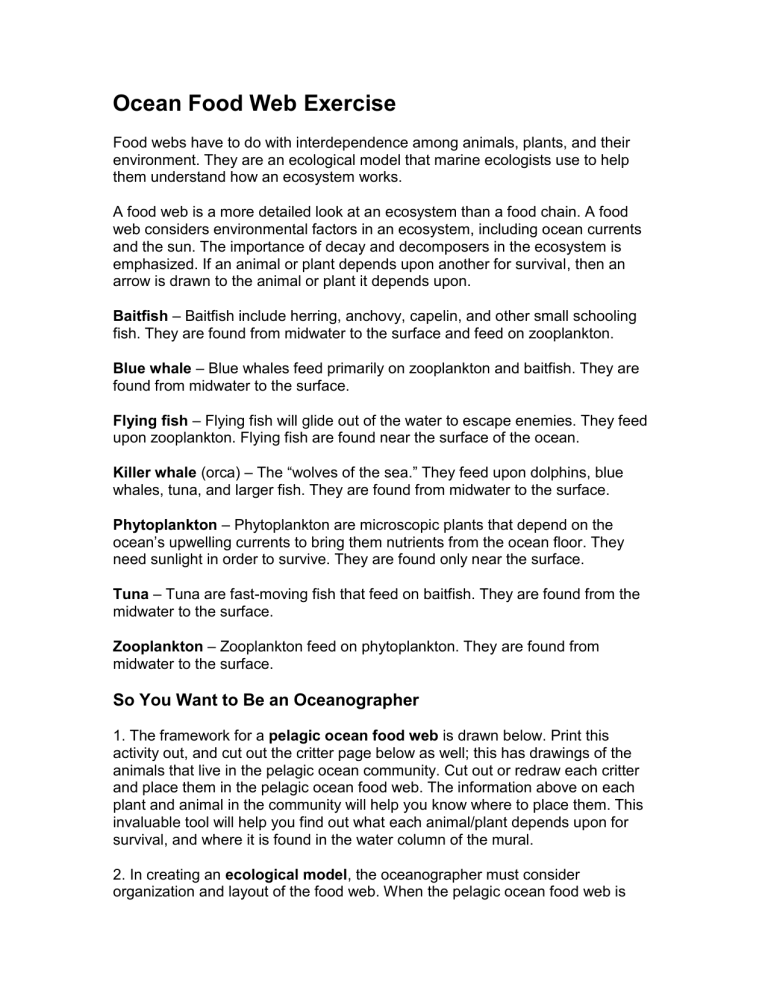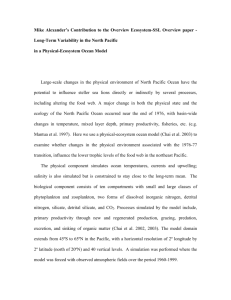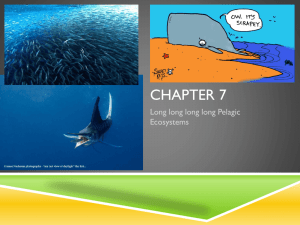Ocean Food Web Exercise

Ocean Food Web Exercise
Food webs have to do with interdependence among animals, plants, and their environment. They are an ecological model that marine ecologists use to help them understand how an ecosystem works.
A food web is a more detailed look at an ecosystem than a food chain. A food web considers environmental factors in an ecosystem, including ocean currents and the sun. The importance of decay and decomposers in the ecosystem is emphasized. If an animal or plant depends upon another for survival, then an arrow is drawn to the animal or plant it depends upon.
Baitfish – Baitfish include herring, anchovy, capelin, and other small schooling fish. They are found from midwater to the surface and feed on zooplankton.
Blue whale
– Blue whales feed primarily on zooplankton and baitfish. They are found from midwater to the surface.
Flying fish – Flying fish will glide out of the water to escape enemies. They feed upon zooplankton. Flying fish are found near the surface of the ocean.
Killer whale (orca) – The “wolves of the sea.” They feed upon dolphins, blue whales, tuna, and larger fish. They are found from midwater to the surface.
Phytoplankton – Phytoplankton are microscopic plants that depend on the ocean’s upwelling currents to bring them nutrients from the ocean floor. They need sunlight in order to survive. They are found only near the surface.
Tuna – Tuna are fast-moving fish that feed on baitfish. They are found from the midwater to the surface.
Zooplankton – Zooplankton feed on phytoplankton. They are found from midwater to the surface.
So You Want to Be an Oceanographer
1. The framework for a pelagic ocean food web is drawn below. Print this activity out, and cut out the critter page below as well; this has drawings of the animals that live in the pelagic ocean community. Cut out or redraw each critter and place them in the pelagic ocean food web. The information above on each plant and animal in the community will help you know where to place them. This invaluable tool will help you find out what each animal/plant depends upon for survival, and where it is found in the water column of the mural.
2. In creating an ecological model , the oceanographer must consider organization and layout of the food web. When the pelagic ocean food web is
completed it should be easy to understand and the entire space should be used.
“Important animals” that are eaten by many others (baitfish and zooplankton) should be placed in the center of the open ocean mural. You may want to do a practice mural first on scratch paper, to plan out where each animal will go.
3. In starting a food web, it is best to begin with the phytoplankton and build from that point. For each animal or plant used from the critter page, you must show what the animal/plant depends upon. This is done by drawing an arrow from the animal/plant to what it depends upon or eats.
4. Each animal and plant should be placed in its correct position in the water column . Positions are noted in the descriptions above. You may find “surface”
(the animal/plant is fo und close to the top); “midwater to surface” (the animal’s range is from the top to the middle); or “deepwater” (the animal is found on or near the ocean floor).
back to top
This is a small version of the activity that appears in the book; it uses more animals than are described above:
Here is the graphic to print out and use for the critters above:








